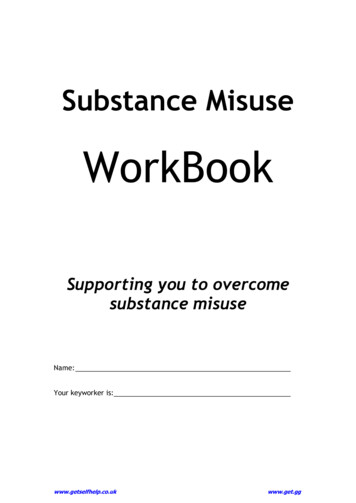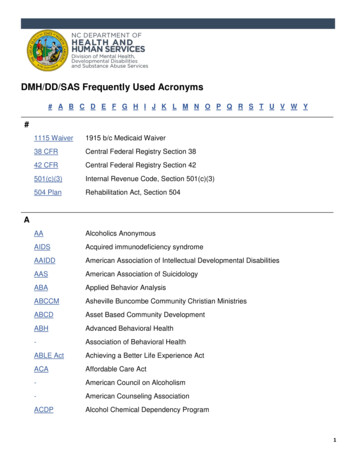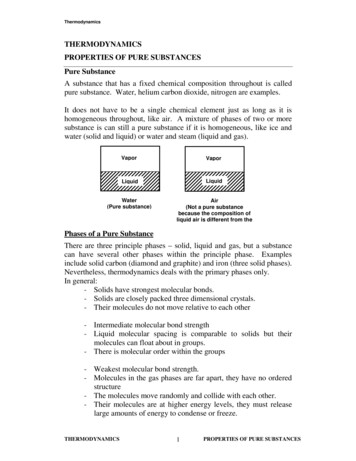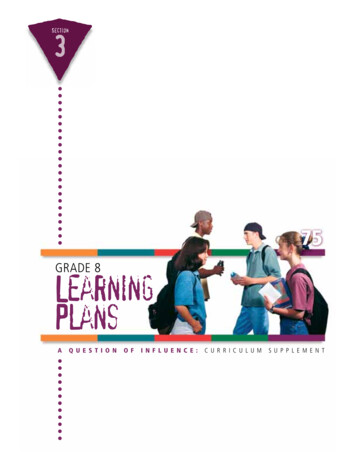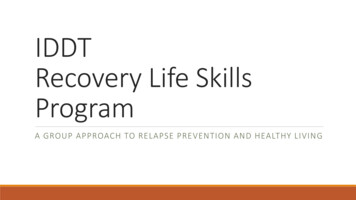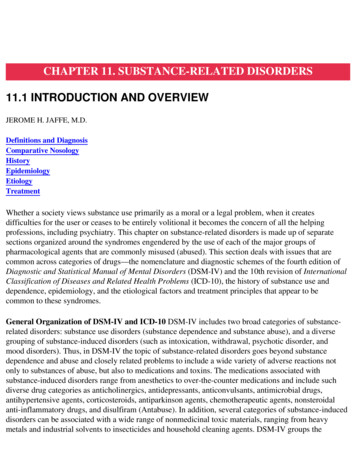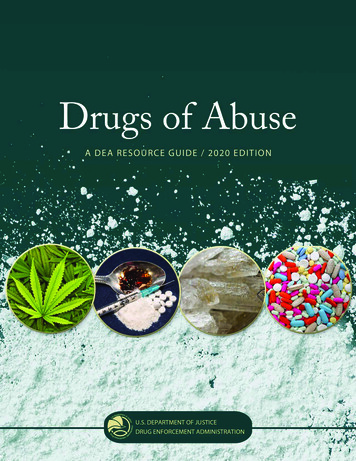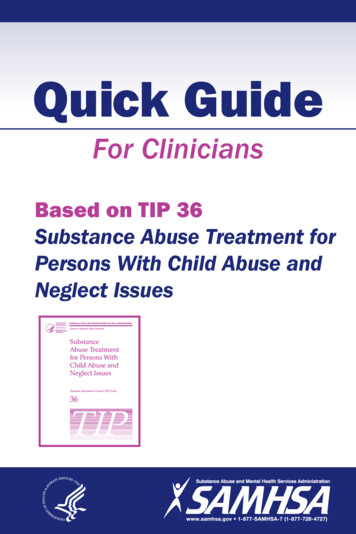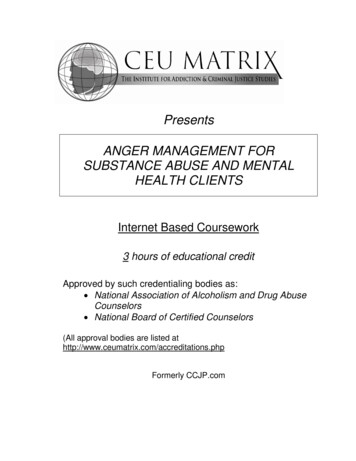
Transcription
CCHCS Care Guide: Substance Use DisorderOctober 2021SUMMARYDECISION SUPPORTGOALSPATIENT EDUCATION/SELF MANAGEMENTALERTS If opioids are required for acute pain management, patients onrelated morbidity and mortality.methadone, buprenorphine/naloxone or naltrexone may require transfer to Equip patients with tools, techniques, anda triage and treatment area (TTA) or hospital, as medically indicated.treatments necessary to successfully Individuals leaving prison are at high risk for overdose-relatedmanage their addiction.harms, therefore everyone will be offered naloxone upon release. Ensure continuity of care while incarcerated Pregnant patients with SUD/Opioid Use Disorder (OUD) require specialistand when reintegrating into the communitymanagement. (See CCHCS Care Guide: MAT for OUD in Pregnancy)when leaving the California Department of Recognizing signs of withdrawal and supporting relapse prevention is aCorrections and Rehabilitation (CDCR).shared responsibility with the entire treatment team. (See CCHCS CareGuide: Intoxication and Withdrawal)SCREENING The treatment team is multidisciplinary, and team members have unique roles and responsibilities in delivering majorcomponents of the program including screening, assessment, treatment, monitoring and transitional services (see page 2). The first question in the National Institute for Drug Abuse (NIDA) Modified Assist (NM-ASSIST) screens for SUD. Affirmative answers in the first question will trigger completion of questions two through eight, which will be referred to as“brief assessment”. (See assessment section below) For details see page 4 and Attachment A.ASSESSMENT Reduce Substance Use Disorder (SUD) Assessment provides additional risk stratification using the NM-ASSIST and/or a multidimensional assessment developed bythe American Society of Addiction Medicine (ASAM) that provides a common language for a holistic, biopsychosocialassessment that is used for service planning and treatment – known as the ASAM Criteria (see page 4 and page 9). Motivational Interviewing techniques may assist with obtaining accurate assessments (see page 6). Diagnostic coding can be derived from 2 differing systems – DSM-5 and ICD-10 (see page 8). Primary Care Providers (PCP) will integrate SUD treatment into their overall patient care plans.TREATMENTComprehensive treatment utilizes behavioral, pharmacologic and/or housing modalities to stabilize an individual. Thesetreatment modalities may be utilized individually or in combination based on patient need and consent. Patients are responsible for their own recovery. The treatment team should work to provide all the evidence-based approachesthat increase their chance at success. Behavioral treatment begins with motivational interviewing techniques and a therapeutic relationship with one’s care team andmay include Cognitive Behavioral Intervention (CBI), Cognitive Behavioral Therapy (CBT) and peer support. Supportive Housing provides designated space where patients can be active participants in their own and each other'srecovery and where they share responsibility for therapeutic interactions among the community and staff. Studies find thatparticipants in such therapeutic communities reduce substance abuse, criminal behavior, and mental health symptoms. Pharmacological treatment (MAT) is available for patients with OUD or Alcohol Use Disorder (AUD). If considered a candidatefor MAT based on assessment findings, the patient will be started on MAT after signed consent.MONITORING Follow-up appointments for patients on MAT are scheduled according to medication and duration of stability (see page 16).Urine drug screens (UDS) are used to monitor MAT adherence and performed randomly at defined intervals (see page 18).Annual labs and other diagnostic tests (e.g., EKG for patients on Methadone) should be done as recommended (see page 16).Follow-up appointments for patients with SUD, but not on MAT, will be based on other clinical conditions.Key performance indicators for institution and providers are included on the ISUDT Dashboard.TRANSITION SERVICES Transition services will be provided for those patients who are part of the ISUDT Program at the time of release in order tofacilitate their ongoing treatment and recovery without interruption. See page 20 for more details. A 30-day supply of medication (MAT) are dispensed at time of release. See page 20.Questions: MAT@cdcr.ca.govTABLE OF CONTENTSISUDT Program Team Composition . 2Treatment Algorithm . 3Screening . 4Assessment . 4-8Treatment - Behavioral . 9-10Treatment - Supportive Housing . 11Treatment - Pharmacologic . 11-15Monitoring for Patients on MAT . 16-19Transition Services . 20Special Circumstances . 21-22Medication Tables . 23-27Patient Education . 29-32Patient Education (Spanish) . 33-36NIDA Quick Screen . 37NIDA Modified ASSIST . 38-41UDS Metabolites and Detection Time . 42-43Informed Consent for MAT . 44Refusal of Examination and/or Treatment . 45Information contained in the Care Guide is not a substitute for a health care professional's clinical judgment. Evaluation and treatment should be tailored to theindividual patient and the clinical circumstances. Furthermore, using this information will not guarantee a specific outcome for each patient.Refer to “Disclaimer Regarding Care Guides” for further clarification: https://cchcs.ca.gov/clinical-resources/1
CCHCS Care Guide: Substance Use DisorderOctober 2021SUMMARYDECISION SUPPORTPATIENT EDUCATION / SELF-MANAGEMENTISUDT ProgramTeam Composition and RolesArrive on MATAlready HereTeam MemberPopulationEPRD 15 to 24The ISUDT Treatment team is multidisciplinary and composed of staff positions within California CorrectionalHealth Care Services (CCHCS), the Division of Rehabilitative Programs (DRP) and the Division of AdultInstitutions (DAI). Each team member has unique roles and responsibilities in delivering major components of theprogram including screening, assessment, treatment, and transitional services that support the patient.Sometimes the roles vary depending on where the patient is in their incarceration lifecycle. There are other staffwho play important roles for patients; however, this table focuses on new positions and/or specific functionsrelated to the ISUDT program.Roles Initial health screening for patients that are new arrivals Release of information (CDCR 7385) to confirm medication/dosage If on MAT, notify Primary Care Team Referrals to Licensed Clinical Social Worker (LCSW) and AMCT For Methadone order Narcotic Treatment Program (NTP) (transport) see page 13 Orders baseline labs per protocol Completes the NIDA Quick Screen, refers to Life Skills if negative If screen is positive, refers to LCSW for NIDA-Modified ASSIST Triage 7362 SUD-related nursing patient care visits Co-consultations on SUD-related 7362 visitsXXXXXXXXXXLVN CareCoordinators Completes the post-induction medication checks (including COWS) at Basic institutionsXXResource RN Coordinates all transitions between Primary Care Teams (PCT), jails, counties, parole, andprobation utilizing the ASAM Re-Entry Interview Script Enhancement (RISE) assessmentcompleted by the LCSW.XXSupervisory Nurse Oversees program components for Whole Person CareXXXSupport Staff Provides support to nursing staff in various programmatic rolesXXXLicensed ClinicalSocial Workers(LCSW) Assess patients with earliest possible release date (EPRD) of 15 to 24 months using ASAM Assess patients with SUD using NM–ASSIST and ASAM Assess patients arriving on MAT using ASAM Provide cognitive behavioral therapy (CBT)XXXXX Conducts group CBI sessions that help get to the root of addiction Helps provide insight into the patient's recovery while participating in CBI Case manage patients toward their goals in rehabilitation Assist with developing relapse-prevention plans Provide counseling, assign job skills training, and encourage educationXXXXXXXXXXXXXXXAddiction MedicineCentral Team(AMCT) Provide consultation and technical support for PCP and Mental Health (MH) providers Review Alternative Agent Authorization (AAA) requestsXXXXXXXXXXXXXXXXXXXXXXPrimary CareProviders (PCP) Identify SUD-related complications, evaluate and initiate for MAT services Manage and monitor integrated SUD services as part of the Complete Care Model (CCM) Continue motivational interviewing to encourage initial and ongoing participation Discharge planning to include MAT Prescriptions Methadone bridge orders at reception and inter-facility transfers to ensure continuity of care Refer to LCSW for SUD assessment Consult with AMCT or institution Champion as neededReception CenterRegistered Nurse(RN)Primary Care TeamLicensed NursingStaffAlcohol and OtherDrug CounselorsCorrectionalCounselors (CC-III)XXXXXXXXPharmacists Process and ensure appropriate MAT orders Assure prescriber X-waivers for buprenorphine orders Assists with medication reconciliation (transfers) Fills and dispenses 30-day medication supply upon release Arranges Naloxone on release via standing orderXXXDentists Identify, evaluate and treat dental complications due to SUDXXXXXXXXX2
CCHCS Care Guide: Substance Use DisorderOctober 2021SUMMARYDECISION SUPPORTPATIENT EDUCATION / SELF-MANAGEMENTSubstance Use Disorder Treatment AlgorithmProgram Entry Points for Patients Already in CDCRPatients Arriving at CDCRReception CenterPatient self-refersvia 7362Reception Center RN: Use initial health screenPatients Leaving CDCR(releasing/paroling within15-24 months)Provider referrals which may includereturn from HLOC, opioid overdose, orSUD-related infection/complicationSee page 10See Page 14For patients arriving on MAT: Obtains outside records to verifycurrent MAT medication and dose Use RCRN Power Plan to:o Refer patients to LCSW forASAM Co-triage and CBI referralo For patients on methadone,place order for NTP (transport)o Order baseline labs Reception Center ProviderContinue patient on the samemedication/dose For Methadone: place 3-daybridge order, add Methadone(administered by NTP), andplace medical hold, and orderbaseline EKG For patient arriving onbuprenorphine-only, switch tobuprenorphine/naloxone unlesspatient is pregnantCheck the Controlled SubstanceUtilization Review and EvaluationSystem (CURES).Order UDS [CCHCS UTOX PANEL(372260)], CMPIf patient on alternate formulation(i.e. injectable), refer to AMCT forconsultationIs patientenrolled in ISUDTProgram?NoDSM-V Criteria Met for a specificSUD (i.e. OUD, AUD)Diagnosis documented inproblems listIf AUD/OUD, consider for MATNurse coconsults withPCPYesFollow the 7362process as outlined inworkflow 600-50 Consult to LCSW forassessment via NIDA-MA Order UDS [CCHCS UTOXPANEL (372260)]PositiveQSNursing screenspatient with NIDAQuick ScreenNegative QSIs NIDA-MA4?NoLCSW referspatient to Life SkillsYesLCSW completes ASAM assessment for levelof care assignment (see page 9) and: Refers patient to CBI If NIDA-MA scores are 16 for opioids or alcoholrefers to provider for evaluationMAT Medication Selection/Initiation Provider evaluates patient for MAT, see Page 10 Provider determines if MAT is clinically indicated (based onDSM-V criteria, UDS result and NIDA-MA score) anddetermines which medication is most appropriate Provider obtains consent for MAT Patient is initiated on chosen medication and follow-up orderedNursing medication check within 72 hours if buprenorphine/naloxone started (see page 14)Monitoring by Provider Monitor labs as recommended in table on page 16 Order random UDS based on frequency determined by treatment duration and patient stability, see page 18Patient continues recommended treatments, which may include MAT, CBI/CBT, peer support groups, supportivehousing and Nursing-Led Therapeutic Groups (See pages 9-15)Parole/Release Planning: ASAM RISE completed 6 months prior to EPRDTreating provider prescribes 30 days of MAT medication and checks CURESFor patients on methadone, patient will be connected to county NTP prior to releaseNursing/pharmacist dispense naloxone upon releaseTransition team coordinates Medi-Cal enrollment, healthcare appointment scheduling, housing, transportation, and other needs3
CCHCS Care Guide: Substance Use DisorderOctober 2021SUMMARYDECISION SUPPORTPATIENT EDUCATION / SELF-MANAGEMENTPatient ScreeningScreening and Assessment ToolsFor the purposes of evaluation and treatment in CDCR we will use the following definitions:Screening: Screening is a process for evaluating the possible presence of a particular problem. The outcome isnormally a simple yes or no. For this we will be using the first question on the NIDA Modified ASSIST (NM-ASSIST), whichaddresses the use of alcohol, prescription drugs for non-medical reasons, and illegal drugs within an individual’s lifetime.Brief Assessment: Brief Assessment is a process for determining a diagnosis and risk severity. For this we will beusing the full NM-ASSIST.Comprehensive Assessment: Comprehensive Assessment is used for developing specific treatmentrecommendations and determining the appropriate level of care for those services to take place. Depending on the stage ofprogram entry or nearing release from prison, we will be using the ASAM Co-Triage, ASAM Continuum, or the ASAM RISE.Patient AssessmentUsed ForInstrumentScreening for SUDNIDA Modified AssistScreen(See Attachment A)First question forsubstances used withinlifetimeAny “Yes” responses, proceed to Brief AssessmentAssessment of RiskRelated to SpecificSubstancesNIDA Modified Assist(See Attachment B)8 questions repeated for 10substancesSubstance Involvement scores0-3 Lower Risk;4-26 Moderate Risk; 27 High RiskASAM Co-TriageAssesses 6 major life areasimpacting a patient’sAddiction/RecoveryUsed for treatment planningResult specifies the “intensity” of treatment requiredfor that particular patientMulti-DimensionalAssessment for Serviceand Treatment PlanningASAM RISEASAM Continuum# of ItemsScoringNIDA - Modified Assist (NM-ASSIST) The NM-ASSIST guides clinicians through a series of questions to identify risky substance use in their patients by consideringlifetime substance use and consequences related to more recent use. Scoring involves summed responses for questions 2-7 for each substance, yielding a substance involvement score. The patient’s risk level is based on their substance involvement score for each substance: 0-3 lower risk4-26 moderate risk 27 high riskASAM Criteria - Comprehensive Multidimensional Assessment The ASAM Criteria is an evidence-based comprehensive multidimensional assessment that provides a structured and common communication platform for service planning and treatment. The Criteria includes evaluation of 6 dimensions (listedon the next page) to provide a holistic, biopsychosocial assessment. Accomplished via computer interface, subsequentscoring helps to determine the level of care or intensity of Cognitive Behavioral Intervention (CBI) support one is assigned to.Patients can move between levels over time, depending on changes in their unique needs.In the community, there are 5 levels of care beginning with early intervention services and progressing to residential inpatientand medically managed intensive inpatient services.Since incarceration already provides for a type of residential service, CDCR adapted the level of care offerings to 3 levels:Education/Relapse Prevention (0.5), Outpatient Services (1.0), and Intensive Outpatient Services (2.1).The ASAM assessments are cloud-based tools that utilize an asymmetric branching algorithm to determine the properquestions to elucidate all six dimensions. It then provides a narrative report and level of care determination. CCHCS will beusing three standardized versions of ASAM assessment: the Co-triage, Continuum and RISE. The Co-triage is an initial assessment that determines provisional assignment for level of care The Continuum is a comprehensive bio-psychosocial assessment that generates a level of care determination The RISE is similar to the Continuum, with a revised script focused on re-entry preparation4
CCHCS Care Guide: Substance Use DisorderOctober 2021SUMMARYDECISION SUPPORTPATIENT EDUCATION / SELF-MANAGEMENTPatient Assessment (cont’d)ASAM DimensionDimension 1:Acute Intoxication and/or Withdrawal PotentialDimension 2:Biomedical Conditions/ComplicationsDimension 3:Emotional/Behavioral/Cognitive Conditionsand ComplicationsDimension 4:Readiness to ChangeConsiderations Are there current signs of withdrawal? Is there significant risk of severe withdrawal symptoms or seizures based on the patient’s previouswithdrawal history, amount, frequency, chronicity and recent discontinuation or significant reductionof alcohol or other drug use? Are there current physical illnesses, other than withdrawal, that need to be addressed or that maycomplicate treatment? Are there current psychiatric illnesses or psychological, behavioral, emotional or cognitiveproblems that need to be addressed because they create risk or complicate treatment? Is the patient able to manage the Activities of Daily Living (ADL)? What is the individual's emotional and cognitive awareness of the need to change?What is their level of commitment to and readiness for change?What is or has been his or her degree of cooperation with treatment?What is their awareness of the relationship of alcohol or other drug use to negative consequences? Is the patient in immediate danger of continued alcohol/drug use or severe mental health distress?Dimension 5:Relapse/Continued Use/ Does the patient have any recognition of, understanding of, or skills to cope with their addictive ormental disorder in order to prevent relapse.Continued Problem How aware is the patient of relapse triggers, ways to cope with cravings to use, and skills to controlPotentialimpulses to use or impulses to harm self or others?Dimension 6:Recovery Environment Does the patient have supportive friendships, financial resources, or educational/vocationalresources that can increase the likelihood of successful treatment?One important aspect of the ASAM Criteria is that it considers the whole patient, including all of their life areas, as well as allrisks, needs, strengths, and goals. Guiding principles for how the ASAM Criteria are used to determine treatment services arelisted here: Consider the whole person. A patient’s risks, needs, strengths and resources provide the basis for creating a treatment plan. Design treatment plans that are patient specific. Every treatment plan is based on the patient’s unique needs, and thereforemay be different, or require a variety of types or intensities of care. Individualize treatment times. Treatment length depends on the patient’s progress and changing needs. “Failure” is not a treatment prerequisite. “Failure” from treatment is NOT a basis for determining correct level of care. Provide a spectrum of services. Levels of care are linked to one another, and patients can move among and between thembased on their current needs.Trauma-Informed Care and SUDTo treat SUD appropriately, it is necessary to re-conceptualize the definition of “addiction.” Addiction is a treatable, chronicmedical disease involving complex interactions among brain circuits, genetics, the environment, and an individual’s lifeexperiences. People with addiction use substances or engage in behaviors that become compulsive and often continue despiteharmful consequences. Prevention efforts and treatment approaches for addiction are generally as successful as those for otherchronic diseases.Many patients with SUD may not have had historical (pre-incarceration) access to or may have overtly avoided stigma-ladenmedical care. In fact, there is a high prevalence of adverse childhood experiences among patients with SUD. Therefore,assessment of a patient with SUD is best achieved in a trauma-informed care environment and over time in the context ofestablishing a therapeutic relationship.A trauma-informed approach focuses on reducing the re-traumatization of traumatized individuals by the professionals whoserve them. Understanding and recognizing the impact of trauma exposure is critical because frequently a person’s behavior – which is anormal reaction to unresolved trauma – is what causes them problems in many life areas. Every effort should be made to prevent further harm and re-traumatization, while creating opportunities for recovery/healing. Without understanding trauma, we are more likely to adopt behaviors and beliefs that are negative and unhealthy. Understanding trauma/stress allows health care staff to act compassionately and take well-informed steps toward wellness.5
CCHCS Care Guide: Substance Use DisorderOctober 2021SUMMARYDECISION SUPPORTPATIENT EDUCATION / SELF-MANAGEMENTPatient Assessment - Motivational Interviewing1Motivational Interviewing is a technique in which the provider becomes a helper in the change process and expressesacceptance of the patient. It is a way to interact with patients with any chronic disease, including SUD, that can help resolve theambivalence that prevents patients from realizing their personal goals. Ambivalence about substance use (and change) is normal and constitutes an important motivational obstacle in recovery.Patients are often aware of the dangers of their use and want to stop, but at the same time do not want to stop – these feelingsare natural, regardless of the patient’s stage of readiness. If a patient’s ambivalence is interpreted as denial or resistance, friction between the provider and the patient is likely to occur.Ambivalence can be resolved by working with the patient’s intrinsic motivations and values. The alliance between the providerand the patient is a collaborative partnership to which each individual brings important expertise.Five Principles of Motivational InterviewingPrincipleApplication to Practice1. Express Empathy(through active listening)2. Develop Discrepancy(between the patient’s goals orvalues and theircurrent behavior)3. Avoid Argument(and direct confrontation)4. Roll With Resistance(rather than opposing itdirectly)5. Support Self-Efficacy Empathy communicates respect for and acceptance of patients and their feelings andencourages a non-judgmental, collaborative relationship. Empathy is the foundation of a motivational counseling style. Developing awareness of consequences helps patients examine their behavior. A discrepancy between present behavior and important goals motivates change. Arguments with patients can rapidly turn into a power struggle and do notenhance motivation for beneficial change. Common types of resistance include arguing, interrupting, talking over or cutting off,denying, blaming, excusing, pessimism, or ignoring. Many patients do not have a well-developed sense of self-efficacy which is oftendemonstrated in their inability to believe they can change. Patient education can increase a patient’s sense of self-efficacy.OARS StrategiesOARS is an acronym that represents 4 interaction strategies for Motivational Interviewing. OARS strategies can be used topropel patients through the change process by eliciting self-motivational statements, or change talk. The OARS strategies are:OARS StrategiesOpen QuestionsEncourage the patient to answer with more than “yes” and “no” answers. Building rapport between theprovider and the patient can facilitate open communication and sharing of information. Open-endedquestions may seem more time-consuming, but can actually be more efficient because they elicit morereliable and complete information and, when skillfully managed, do not have to lead to lengthy discussions. “Tell me about your family.”AffirmationAffirmation through statements of empathy and support of past accomplishments and strengths in order toanchor patients to their strengths and resources as they address problem behaviors. Affirmations helppatients feel more comfortable, forthcoming, and open to feedback. Affirmations can be brief but powerfulin building a therapeutic alliance. “This meeting brought out a lot of painful feelings. Thank you for staying through it.”ReflectiveListeningReflections are restatements of a patient’s words or guesses at what a patient means. Providers whoreflect are, in essence, acting as mirrors for patients to hear back what they have said. Hearing someonerepeat back to you what you are saying may increase insight and self-reflection. Reflections are not meantto be directive, but to allow patients to elaborate on their concerns. “What I hear you saying is you want to quit, but your cell mate is making it hard for you.”SummaryReflectionsSummarizing is simply a set of reflections gathered together and presented to the patient. Summaries helppatients and families organize their experiences. Summarization brings closure and consensus to whathas been discussed and sets the stage for next steps. A summary statement often ends with a question. “What you’ve said is important and I want to make sure I have it right .”6
CCHCS Care Guide: Substance Use DisorderOctober 2021SUMMARYDECISION SUPPORTPATIENT EDUCATION / SELF-MANAGEMENTPatient Assessment - History and Physical examHealthcare Providers will evaluate patients prior to initiating MAT.Initial Evaluation History will include, but is not limited to, identifying and documenting the following: The patient’s primary substance(s) of choice When substance use first began, first use of each substance, pattern of use of each substance The patient’s current level of cravings History of past or current MH conditions and current level of stress, anxiety or depression History of past or current trauma (the patient may not want to discuss at the first visit; if not, wait until trust is developed) History of prior substance use treatment The patient’s current motivation for sobriety The patient’s family history regarding substance use Prior screening for Tuberculosis (TB), Hepatitis A (HAV), Hepatitis B (HBV), Hepatitis C (HCV), Human ImmunodeficiencyVirus (HIV), and Syphilis (RPR) (if screening is not done - order)Providers must check CURES if: Controlled medication has been ordered within 12 months of incarceration Controlled medication is prescribed at time of release/parolePhysical Exam: Focus on signs of substance use or complications of substance use:SystemAreas of Substance Use FocusGeneral ObservationLevel of interaction, pale or flushed, lethargic or active, agitated or calm, cooperative or combative,abnormal movementsHead, Eyes, Ears, Nose Pupil size, yellow sclera, conjunctivitis, rhinorrhea, rhinitis, excoriation or perforation of nasal septum,& Throat (HEENT)epistaxis, sinusitis, hoarseness or laryngitis, poor dentition, gum disease, dental abscessesSkinAbscesses, rashes, cellulitis, thrombosed veins, jaundice, scars, track marks, pock marksHeartMurmurs, arrhythmiasRespiratoryDyspnea, rales, hemoptysisMusculoskeletal/ExtremitiesPitting edema, broken bones, traumatic amputations, burns on fingersGastrointestinalHepatomegaly, hernias, hematemesisOtherEvidence of acute intoxication or withdrawal, e.g., slurred speech, unsteady gait or impaired balance/coordination, bizarre or atypical behavior, changes in level of arousal (agitation or sedation)Patient Assessment - Diagnostic TestsPrior to initiating MAT, screening for TB, HBV, HCV, Hepatitis A, HIV, and Syphilis is done along with Comprehensive MetabolicPanel (CMP), UDS, and Urine beta-hCG (for women), and EKG (for Methadone). See table on page 16 for more details.7
CCHCS Care Guide: Substance Use DisorderOctober 2021SUMMARYDECISION SUPPORTPATIENT EDUCATION / SELF-MANAGEMENTPatient Assessment - DiagnosisMaking a diagnosis requires a thorough evaluation and often includes assessment by multiple care team members. There aretwo different coding systems used for diagnosing SUD - DSM-5 and ICD-10. Either are acceptable to use. Each are furtherdescribed below.SUD Diagnosis—DSM-5The Diagnostic and Statistical Manual of Mental Disorders (DSM-5) provides criteria that can be used to diagnose SUD and itsseverity.The DSM-5 has shifted from the use of the term "addiction" to "substance use disorders" and has integrated the concepts ofsubstance abuse and substance dependence into the diagnosis of SUD. Inhalant-related disordersTobacco-related disordersOther, or unknown, substance-related disordersCaffeine-related disordersHallucinogen-related disorders Alcohol-related disordersOpioid-related disordersCannabis-related disordersSedative, hypnotic, or anxiolytic-related disordersStimulant-related disordersThe DSM-5 separates SUD into different categories, based on the substance being abused.The DSM-5 defines SUD as: “A problematic pattern of alcohol and drug use leading to clinically significant impairment ordistress, as manifested by at least two of the following, occurring within a 12-month period”.9 The criteria have been dividedbased on how they manifest in behavior.Loss of ControlAdverse Consequences Taking larger amounts or for longer than intendedWanting to cut down or quit but unable toIncreasing time getting, using, andrecovering from use of the substanceCravingRe
Jul 09, 2019 · CCHCS Care Guide: Substance Use Disorder SUMMARY DECISION SUPPORT PATIENT EDUCATION / SELF-MANAGEMENT October 2021 NIDA -Modified Assist (NM-ASSIST) The NM-ASSIST guides clinicians through a series of questions to identify risky substance use in their patients
